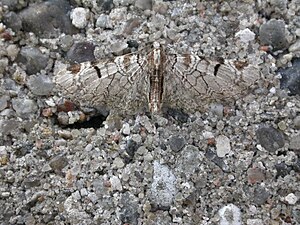Orchard pussycat
| Orchard pussycat | ||||||||||||
|---|---|---|---|---|---|---|---|---|---|---|---|---|

Orchard flyer ( Eupithecia insigniata ) |
||||||||||||
| Systematics | ||||||||||||
|
||||||||||||
| Scientific name | ||||||||||||
| Eupithecia insigniata | ||||||||||||
| ( Huebner , 1790) |
The orchard flyer ( Eupithecia insigniata ) is a butterfly ( moth ) from the family of the flyer (Geometridae).
features
butterfly
The wingspan of the moth is 18 to 24 millimeters. The basic color of the forewings ranges from white-gray to ash-gray to bluish-gray. On the front edge there are four distinct dark brown spots that run out towards the rear edge as thin, mostly double lines. The two middle spots are connected to each other in some specimens. The blackish central point is stretched. The butterflies are unmistakable due to the very striking drawing. The scientific name of the species is derived from the Latin insignis = striking. The hind wings are less drawn and sometimes slightly lighter than the forewings.
egg
The whitish egg has a slightly oval shape. The bowl sculpture shows some depressions that are enclosed by raised ledges.
Caterpillar
The very slender caterpillars taper towards the front. They are bright green in color. A purple line can be seen on the back that expands or dissolves into spots on each segment. These are sometimes bordered in yellow. The side stripes are thin, reddish and sometimes dissolved in spots.
Doll
Greenish wing sheaths stand out from the slender, mostly yellow-brown pupa . It has a blunt cremaster that is equipped with eight small, thick bristles.
Geographical distribution and occurrence
The orchard moth occurs in large parts of Central and Southern Europe, also in Asia Minor and can be found in the Alps up to 1600 meters, in the Apennines up to 1500 meters and in Turkey up to 2200 meters above sea level . The northernmost distribution extends to southern England and southern Sweden . The species prefers dry and warm hedges and bushes, orchards, orchards and gardens.
Way of life
The moths are nocturnal and fly in a generation with flight times from April to May, but were also found occasionally in March or June. They appear in both sexes in artificial light sources . The caterpillars live in May and June and feed on the leaves and flowers of various hawthorn ( Crataegus ) or fruit tree species . Often they can be found on cultivated apples ( Malus domestica ), crab apples ( Malus sylvestris ), single hawthorn ( Crataegus monogyna ) or sloe bushes ( Prunus spinosa ). The pupae overwinter, sometimes two or three times.
Danger
In Germany the orchard bloom moth is widespread locally, occurs in different numbers in the individual federal states and is listed in Category 3 (endangered) on the Red List of Endangered Species .
swell
Individual evidence
- ↑ a b c Vladimir Mironov: The Geometrid Moths of the World . In: Axel Hausmann (Ed.): The Geometrid Moths of Europe . 1st edition. Volume 4: Larentiinae II. Perizomini and Eupitheciini . Apollo Books, Stenstrup 2003, ISBN 87-88757-40-4 (English).
- ^ Arnold Spuler: The butterflies of Europe , Volume 2, E. Schweizerbart'sche Verlagsbuchhandlung, Stuttgart, 1910
- ↑ Walter Forster , Theodor A. Wohlfahrt : The butterflies of Central Europe. Volume 5: Spanner. (Geometridae). Franckh'sche Verlagshandlung, Stuttgart 1981, ISBN 3-440-04951-5 .
- ^ Günter Ebert (Ed.): The butterflies of Baden-Württemberg. Volume 9. Moths VII. Geometridae 2nd part . 1st edition. Ulmer, Stuttgart (Hohenheim) 2003, ISBN 3-8001-3279-6 .
- ↑ Federal Agency for Nature Conservation (Ed.): Red List of Endangered Animals in Germany . Landwirtschaftsverlag, Münster 1998, ISBN 3-89624-110-9 .
literature
- Vladimir Mironov: The Geometrid Moths of the World . In: Axel Hausmann (Ed.): The Geometrid Moths of Europe . 1st edition. Volume 4: Larentiinae II. Perizomini and Eupitheciini . Apollo Books, Stenstrup 2003, ISBN 87-88757-40-4 (English).
- Günter Ebert (Ed.): The butterflies of Baden-Württemberg. Volume 9. Moths VII. Geometridae 2nd part . 1st edition. Ulmer, Stuttgart (Hohenheim) 2003, ISBN 3-8001-3279-6 .
- Manfred Koch , Wolfgang Heinicke, Bernd Müller: We determine butterflies. Volume 4: Spanner. 2nd, improved and enlarged edition. Neumann, Leipzig / Radebeul 1976, DNB 780451570 .
Web links
- Lepiforum e. V. Photos
- ukmoths.org.uk UK moths
- www.schmetterlinge-deutschlands.de Endangerment
- Eupithecia insigniata in Fauna Europaea. Retrieved July 7, 2012